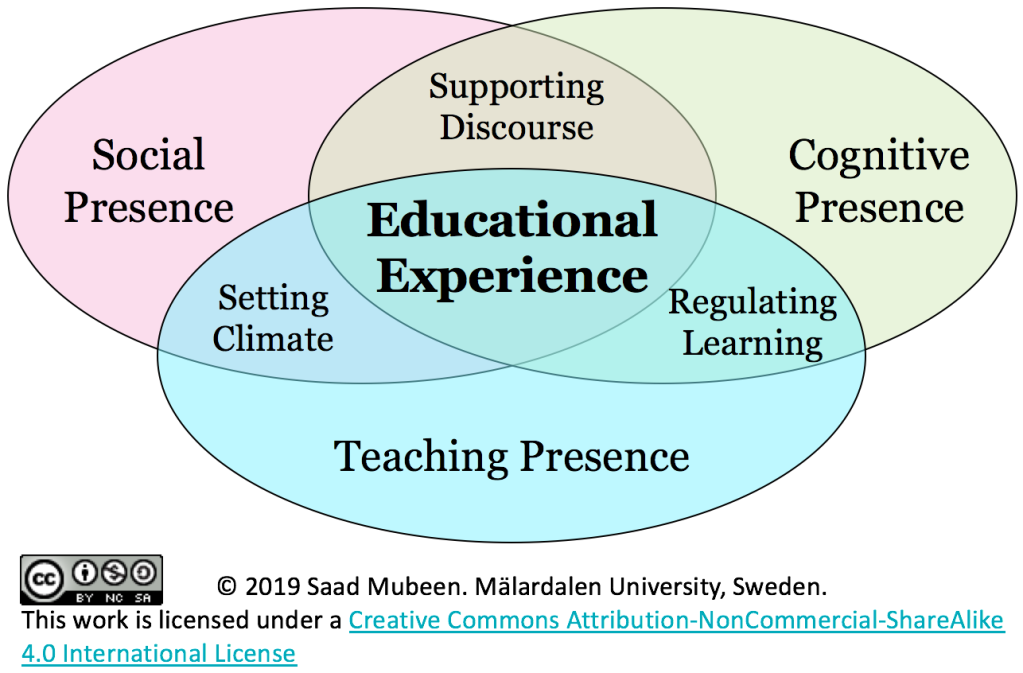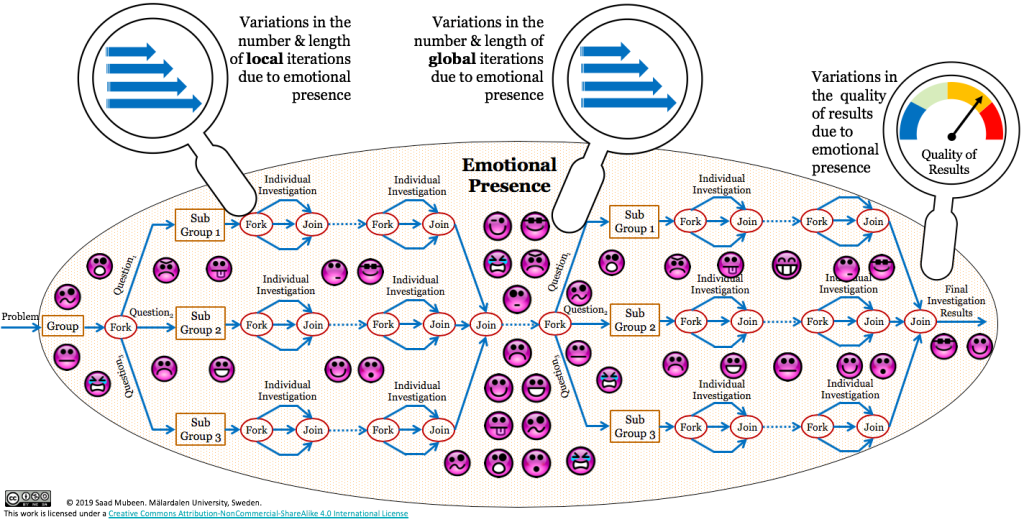This blog explores the effects of emotions on collaborative learning in the Problem Based Learning groups. In this regard, the blog revisits the hierarchical iterative fork-join collaboration model and superimposes this model with the effect of emotions.
Let’s start by looking at the vital prerequisites to a successful educational experience in higher education, which is described in the Community of Inquiry framework by Garrison, Anderson and Archer [1]. According to this framework, also depicted graphically in Figure 1, there are three prerequisites to a successful educational experience: (i) social presence, (ii) cognitive presence, and (iii) teaching presence. A seamless interaction of these three elements can lead to an effective learning experience in a community.
 Figure 1. Elements of an educational experience according to the Community of Inquiry framework. The figure is adapted from the work in [1].
Figure 1. Elements of an educational experience according to the Community of Inquiry framework. The figure is adapted from the work in [1].
Several researchers have advocated that emotions can also play a significant role in an educational experience. In this regard, Cleveland-Innes and Campbell [2] have identified several emotions, e.g., appreciation, delight, desire, disappointment, dislike, enjoyment, excitement, fear, frustration, happiness, hope, humour, irony/sarcasm, like, passion, preference, pride, surprise, thankfulness, unhappiness, wonder, just to name a few. According to Gruber [3] and Lehman [4] Emotions and learning have a considerable impact on each other. Hence, these two elements cannot be considered as isolated from each other.
The Community of Inquiry framework implicitly considers emotional expressions as part of the social presence in its coding template [1]. However, the original framework does not consider emotional presence as the first-class prerequisite element for the educational experience. According to Cleveland-Innes [2], the emotional presence is defined as:
“The extent to which learners and teachers adapt their behaviour to accommodate the overt and covert presence of emotion.”
I fully agree with the above mentioned works in considering the emotional presence as one of the fundamental elements in achieving a successful educational experience. In my point of view, emotions are present in all the elements that constitute the Community of Inquiry framework, including the social, cognitive and teaching presence. This point of view is completely in line with the thesis of Cleveland-Innes and Campbell [5]. Assuming that the original Community of Inquiry framework is drawn on a two-dimensional plane as shown in Figure 1, the element of emotional presence should be considered as the third dimension in the framework as shown in Figure 2.
 Figure 2. Adding emotional presence to the Community of Inquiry framework. The proposal is in line with Cleveland-Innes and Campbell [2] and Cleveland-Innes [5].
Figure 2. Adding emotional presence to the Community of Inquiry framework. The proposal is in line with Cleveland-Innes and Campbell [2] and Cleveland-Innes [5].
The emotional presence plays a key role in a successful collaboration within a Problem Based Learning group. Positive emotions such as appreciation, delight, enjoyment, excitement, happiness, hope, humor, passion and thankfulness, to mention a few, can create trust, comfort and high cohesion within the group. In my experience, humor, appreciation and thankfulness help a lot in socializing within the group, thereby strengthening the sense of community. Whereas, negative emotions such as disappointment, dislike, fear, frustration, irony/sarcasm, unhappiness, confusion can have an adverse effect on the collaboration.
The hierarchical iterative fork-join collaboration model and its enhancement hierarchical iterative fork-join collaboration model were developed without considering the effects of emotions in collaborative learning. Naturally, the following question comes to mind:
What is the impact of participants’ emotions on collaborative learning if the group uses the hierarchical iterative fork-join collaboration model?
First, consider the iterative fork-join collaboration model. In my opinion, if the emotional presence is superimposed on this model, the structure of the model should remain intact. However, the number and the length of fork-join iterations, depth of investigation, cohesion within the collaboration, and quality of findings and results can vary significantly with respect to the emotional presence in the group as shown in Figure 3. While positive emotions can shorten the number of fork-join iterations, the time interval between iterations, and improve the quality of investigation and results, negative emotions can have an adverse effect on these factors when the same collaboration model is used. Similarly, the hierarchical iterative fork-join collaboration model superimposed by the emotional presence for collaborative problem solving in Problem Based Learning groups is graphically depicted in Figure 4. Note that in this model, the number and length of both local and global iterations are affected with the presence of emotions.
 Figure 3. Iterative fork-join model superimposed by the emotional presence for collaborative problem solving in Problem Based Learning groups.
Figure 3. Iterative fork-join model superimposed by the emotional presence for collaborative problem solving in Problem Based Learning groups.
 Figure 4. Hierarchical Iterative fork-join model superimposed by the emotional presence for collaborative problem solving in Problem Based Learning groups.
Figure 4. Hierarchical Iterative fork-join model superimposed by the emotional presence for collaborative problem solving in Problem Based Learning groups.
In crux, emotional presence plays a significant role in learning and educational development within a collaborative problem based learning group. Hence, it is vital that the educators, facilitators and participants facilitate and promote a social environment within the group, especially in the beginning, where everyone feels safe and comfortable to show their emotions.
References:
[1] D. R. Garrison, T. Anderson, W. Archer, Critical Inquiry in a Text-Based Environment: Computer Conferencing in Higher Education, The Internet and Higher Education, Volume 2, Issues 2–3, 1999, Pages 87-105, ISSN 1096-7516, https://doi.org/10.1016/S1096-7516(00)00016-6.
[2] M. Cleveland-Innes and P. Campbell (2019). Emotional Presence, Learning, and the Online Learning Environment, in the International Review of Research in Open and Distance Learning, Volume 13, Issue 4, 2012, available: https://files.eric.ed.gov/fulltext/EJ1001716.pdf, accessed 2019-11-27.
[3] TeDtalk: J. Gruber, Yale University, Human Emotion 12.1: Emotion and Cognition I (Introduction), published Jun 4, 2013, accessed Nov 25, 2019, available: https://www.youtube.com/watch?v=y6RNTxdKxmE&index=34&list=PLeCFWdLZpnW_58U1CahaFtlS-hfWwuFAr
[4] R. Lehman, The role of emotion in creating instructor and learner presence in the distance education experience, Journal of Cognitive Affective Learning, Volume 2, Issue 2,2006.
[5] Cleveland-Innes, M. (2019). Emotion and learning – emotional presence in the Community of Inquiry framework (CoI)? Video available: https://athabascau.adobeconnect.com/pyx24rifa1yw/?proto=true